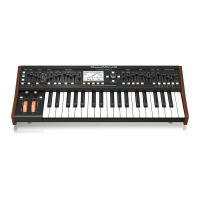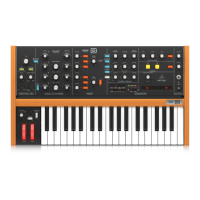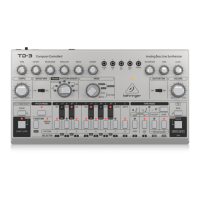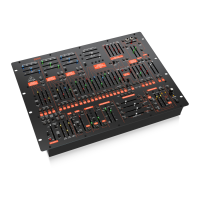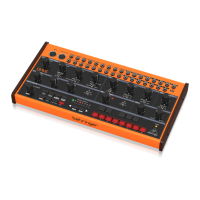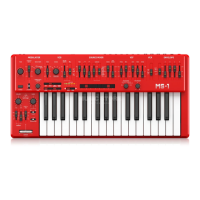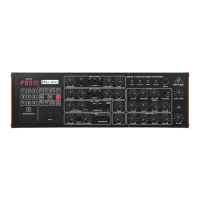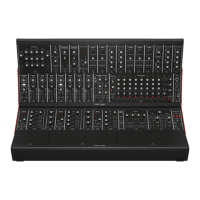146 DeepMind 12 User Manual
23. Denition of Terms
This glossary provides an explanation of the symbols, terms and abbreviations
used in this manual.
16'/8'/4': Used to describe the range of an oscillator, this term originates from
pipe organs. The length of the pipe is inversely proportional to the pitch it
produces, for example, a 4' pipe is one octave higher than an 8' pipe.
ADC or A/D: Analog to Digital Converter, used to describe the process of
signal conversion
AC: Alternating Current
ADSR: Attack, Decay, Sustain and Release, an envelope with four stages.
Aftertouch: The pressure applied to a key after it has been pressed.
This pressure is converted into a MIDI signal to allow the amount of pressure to
modulate another parameter.
Algorithm: A process or set of rules used to accomplish an operation.
Amplier: A circuit which increased the level of a signal.
Amplitude Modulation (AM): Modulation of the amplitude (or level) of a
sound by another signal source. AM is used to produce tremolo using a low
frequency modulation source.
Analog: Something which is proportional or similar to something else. In the
case of the synthesizer, audio electronic circuits are another form of air pressure
waves. Analog signals contain distortions from the components, topology,
circuits and designs which are often perceived as warmer and more natural than
their digitally generated counterparts.
Arpeggiator: An "Arpeggio" is a number of notes played sequentially instead
of simultaneously. The Arpeggiator responds to a number of keys being held by
playing a sequence of notes. The notes, and their sequence can be congured
using the preset modes of operation.
Attack Time: The rst stage of an ADSR envelope, used to control the initial
part of a sound. Specied as the duration of time for an envelope to reach the
maximum level after it has been triggered on by a key press or gate signal.
Attenuate: To reduce the level of a signal.
Automation: The recording and playback of control signals.
Auto-panning: An eect which cyclically adjusts the position of the audio signal
within the stereo eld.
Balanced Audio: A type of audio connection that uses the three wires in a cable
as part of a phase-cancelling arrangement to boost the signal and reduce noise.
Band: A range of frequencies.
Bandwidth: The dierence between the upper and lower frequencies of a lter.
Bank: A group of programs
Bass: Lower frequencies in a signal ranging from 60 Hz to 250 Hz
(Approximately B1 to B3).
Beat Frequency: When two waveforms of dierent frequencies are mixed
together, the resulting waveform will have points of constructive and destructive
interference. The beat frequency is equal to the dierence in frequencies and is
heard as a "beating" or amplitude modulation.
Beats Per Minute (BPM): Used to describe the tempo of a composition by
specifying the number of beats which should occur in every minute.
Cent: Unit of measurement for pitch tuning. There are one hundred cents
in a semitone.
Chorus: An eect which uses multiple copies of a signal played together and
slightly out of time, to create a shimmering eect. Sometimes referred to as
“Ensemble”.
Clock: A digital waveform typically square which is used as a timing source for
other components in a system.
Comb Filtering: Removal of signal components using a lter shape with a
number of regularly spacedfrequencies.
Compressor: A dynamics processor that reduces the level of any signal
exceeding a specied threshold volume.
Continuous Controller: A type of MIDI message assigned to a specic
parameter. When the parameter is adjusted a continuous controller messages are
sent. If the assigned continuous controller is received then the parameter will
be adjusted.
Control Voltage (CV): A voltage signal used to control any parameter.
Was common on synthesizers before MIDI, and is now found mostly on
modular synthesizers.
Cross-Modulation (X-Mod): Two oscillators modulating each other at the same
time. The outputs is a mix of the sum and dierence of the oscillators. The term
is also used to describe the ability for parameters of a synthesizer to be able to
modulate other parameters.
Cut-O Frequency: The frequency which a lter is set to. Beyond this frequency
(in a low-pass lter, the most common), the sound is cut o (attenuated) at a rate
set by the slope of the lter response curve.
Cycle: In a sound wave, the cycle refers to a single repetition of a wave-shape.
For example, in a square waveform, it is the time from a positive edge to the next
positive edge.
DAC or D/A: Digital to Analog Converter, used to describe the process of signal
conversion
Data: Digitally stored information
dB: Symbol for “decibel”. A unit of measurement of the loudness of sound.
SeedBu.
dBu: A unit of measurement of sound used in professional audio. Derived from
the decibel, where the “u” stands for unloaded, this unit is an RMS measurement
of voltage based on 0.775 VRMS, which is the voltage at which you get 1 mV of
power in a 600 Ohm resistor. This used to be the standard impedance in most
professional audio circuits.
DC Oset: An imbalance that sometimes occurs in A/D converters. It is a
constant voltage that is present, which can eat up headroom and cause clicks and
pops during editing.
Decay Time: The second stage of an ADSR envelope. Specied as the duration of
time for an envelope to reach the sustain level after the maximum level has been
reached during the attack stage.
Default: An initial value for parameter, i.e., the value before any changes have
been made.
Delay: An eect by which a reproduction of a signal is played back later then
itsoriginal. Primarily used for echo, but also is the basis for phasing, anging,
chorus and basic reverb type eects.
Detuning: The action of adjusting the pitch of an oscillator from a reference
point or another oscillator. When oscillators are detuned slightly they will make
the output sound "fatter" or "wider". When oscillators are detuned heavily to
note intervals it can create harmonies.
Digital Audio Workstation (DAW): A computer based recording system.
More commonly used to describe the software package used to record,
process and mix.
Digitally Controlled Oscillator: An analog oscillator circuit controlled and
monitored by a digital processor. The advantages over a VCO is increased stability
which results in far less tuning drift.
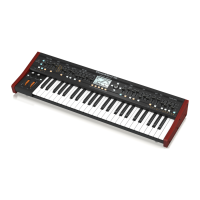
